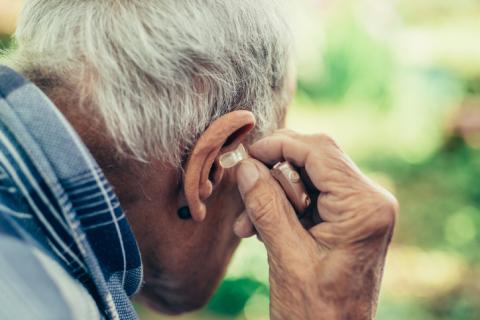Pandemic Precautions Challenge Those With Hearing Loss
First, no matter where they live, at home or in a senior living community, older adults have had greatly reduced opportunities for social interaction. Because of this, reports the AAA, many people who have hearing aids aren’t using them. This is a serious problem, because with reduced sound input to the brain, a person can experience “auditory deprivation” that causes a decline in hearing ability. “Family members and friends should encourage their loved ones to continue to use their hearing aids—there is always sound around us,” explains AAA president Catherine Palmer, Ph.D.
Palmer also notes that some seniors have been unable to get to their audiologist for routine care of their devices. “Hearing aids require ongoing maintenance and, for some individuals their hearing aids may not be functioning well or at all and they may not be able to get to their audiologist for routine care,” she says. “If an individual continues to use their hearing aid when it is not working, it functions like an earplug—actually blocking sound.”
Fortunately, Palmer reports, the situation is improving. Some audiologists are offering telehealth appointments and curbside care. Many senior living communities now allow audiologists into the building with proper safety measures.
Other experts agree this is an important time to consider the effect of the pandemic on people with hearing loss. We now know that hearing loss not only leads to loneliness and isolation, but also increases a person’s risk of dementia. Poor hearing is linked to falls, as well. “When it is harder to understand speech—whether because of cloth face coverings, distance, or other factors—research suggests that we have fewer cognitive resources to process information deeply,” says Debra L. Tucci, director of the National Institute on Deafness and Other Communication Disorders (NIDCD). “As a result, communication suffers, and feelings of stress and isolation may increase.”
During the pandemic, there’s been an ongoing struggle to balance safety with the human need for connectedness, and this is yet another example: Wearing masks, standing at a distance and outdoor interactions make it harder to hear. The NIDCD says we should all be mindful of this. For anyone, visual cues are important when talking to another person. For people with hearing loss—which includes more than half of older adults—lip reading and picking up visual cues from a person’s facial expressions are especially important tools for understanding speech.
The NIDCD reminds everyone to take extra care at this time when communicating with people who have hearing loss. If you are the one with low hearing, let people know. If you can’t understand them, ask them to speak slowly and louder, and to enunciate. If possible, move the conversation to a place without a lot of background noise. Alternately, write things down or suggest a video chat. Turn on captioning if you can. Reusable clear masks also are available, with design improvements in the works.
“These difficult times offer all of us the opportunity to be mindful about communication,” says Tucci. “It will require extra effort. I encourage everyone to meet these challenges with patience, kindness, and a commitment to problem solving.”
